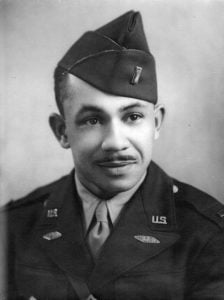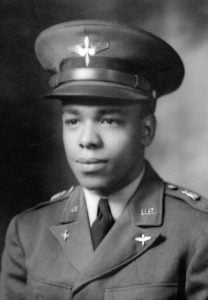Among the family and friends laid to rest in the Alton, Illinois, town cemetery, war heroes and brothers George and Arnold Cisco hold a unique distinction, tucked away unnoticed for decades. They both served in World War II as part of the famed Tuskegee Airmen, our nation’s first black military pilots and their support personnel. After all these years, members of the Alton community want to ensure their service – and the mark it left on history – will be honored and remembered for future generations.
The Tuskegee Airmen Cisco Memorial Committee of Alton has been leading a crowdfunding campaign to commission an upright granite memorial to the men. Unfortunately, the obscure, flat gravestones that currently mark their resting place do not give any indication of their important service as Tuskegee Airmen. Their project aims to change that with a monument that will include their images and that of the infamous fighter aircraft they flew in the war, educating and inspiring people about the legendary Tuskegee Airmen.
Committee members include local residents Charlie Baird, United States Army veteran; Eugene Jones Baldwin, a researcher and interviewer in the Department of the Interior’s National Tuskegee Airmen Oral History Project; Lorenzo Small, nephew of George and Alton Cisco; and members and staff of the Alton Museum of History and Art.
“The Cisco brothers had remained relatively unknown for 70 years and it is well past time they got the recognition they deserve,” said Brian Combs, president of the Alton Museum of History and Art. “Our museum has labored a long time to preserve our community’s history and bring an appreciation to the stories and contributions of people like George and Arnold Cisco.”
Alton’s black heritage includes helping slaves find safety in their free state. Its proximity to the Mississippi River made it an important part of the Underground Railroad, and is part of nine such sites in the region. The graves of the Cisco brothers are near the tomb and monument of Elijah P. Lovejoy, an outspoken abolitionist who was a minister and owner of the Alton Observer. In 1847, Lovejoy was killed by a pro-slavery mob that destroyed his printing press in an attempt to hinder abolitionist writings.
The monument is expected to be unveiled June 3, 2017, although efforts are ongoing to raise the last of the funds needed to finish the project. Those interested in contributing can visit their crowdfunding site to learn more and make a donation. Honoring the Cisco brothers is an important step towards shining a light on an important and overlooked piece of local history.
To help educate the community about the Tuskegee Airmen and the Cisco Brothers, the Alton Museum of History and Art hosted a free screening of “In Their Own Words: The Tuskegee Airmen” in early March. Additional events and fanfare are planned to mark the unveiling of the monument in June, including another opportunity for the community to view the film.
George and Arnold Cisco were born in 1918 and 1920 respectively and raised in Jerseyville with their parents, Roscoe and Flora Cisco, and younger brother Harlow. The rural town was just 20 miles north of Alton. Their father was a well-known musician in the area, playing piano and teaching music.
The two brothers graduated with honors from Jerseyville High School and went on to earn degrees from the University of Illinois where they were both members of the Kappa Alpha Psi fraternity.
All three sons served their country in the armed forces. George had enlisted in the Army and graduated from officer training school as a second lieutenant in 1943. He was originally assigned to the 761st Tank Battalion, a segregated unit. He transferred to the U.S. Army Air Corps and earned his wings as a Tuskegee Airman on May 23, 1944.
Tragically, at age 26, George was killed in a training accident before he ever served overseas, and was the first person of color from Jersey County to lose his life in the war effort. During a routine training mission on August 16, 1944, George’s aircraft was on the runway at an airfield in Walterboro, South Carolina, when it was struck by another plane coming in for a landing. He left behind his wife, Clara Beatrice, and their infant daughter, Donna.
“It was Arnold that encouraged George to fly. He left the Army and joined the Air Corps to become a pilot,” remembers Clara. She had also attended the University of Illinois before graduated from St. Mary’s University in San Antonio. She worked as a schoolteacher for 16 years. “The history of the Tuskegee Airmen is a picture of black history most kids won’t get the chance to learn. It’s important to understand because it can encourage young people to discover futures in aviation, aeronautics or anything they might want to set their minds to. Telling the stories of the Tuskegee Airmen also keeps their memories alive.”
Arnold earned his wings as a Tuskegee Airman and was assigned to the 99th Pursuit Squadron, eventually deployed to Ramitelli Air Base in Italy. There he flew the famous P-51 Mustang fighter in ground strafing and bomber escort missions, and earned the nickname Red Tail along with his fellow pilots for their tenacity, and the tails of their planes they painted red. His wartime service earned him the Distinguished Flying Cross, Air Medal with Oak Leaf Clusters, World War II Victory Medal, American Campaign Medal and the European–African–Middle Eastern Campaign Medal.
In another tragic turn of fate for the Cisco family, Arnold was tragically killed at the young age of 26 during military leave to visit his family. On May 19, 1946, the transport plane he was on hit power lines during a storm and crashed near Tuskegee, Alabama. He had been in Chicago to visit his wife, Hennie, who was pregnant at the time with their son, and was on his way back to Tuskegee where he was to be promoted to the rank of Major before returning to fight overseas.
Because the family lost two of their three children to the war, their youngest son, Harlow, was honorably discharged after three years of service in the Army when the Korean War broke out. According to the Sole Survivor policy that was enacted in 1948, the military was compelled to excuse a family’s sole survivor from active service during wartime.
The history of the Cisco family is a lesson in service, sacrifice and determination to press on in the face of great adversity. The community of Alton and Jerseyville will proudly erect their monument so these forgotten heroes can stand as a beacon of inspiration and courage.
The CAF Red Tail Squadron salutes George and Arnold Cisco, and remembers the great sacrifice of their family.
The CAF Red Tail Squadron is a volunteer-driven organization dedicated to educating audiences across the country about the history and legacy of the Tuskegee Airmen, America’s first black military pilots and their support personnel. Learn more at www.redtail.org.







